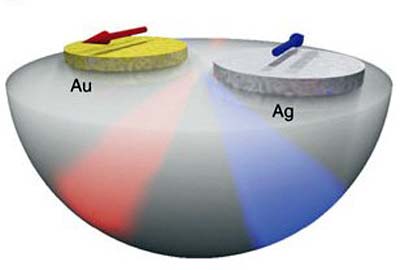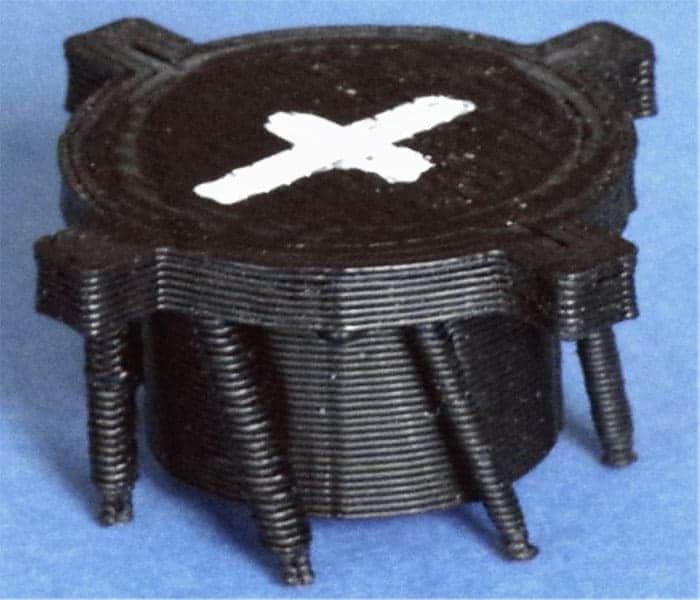
Researchers in Sweden have invented a tiny antenna that can direct red and blue light in opposite directions. The device comes as a surprise because it relies on structures that are smaller than the wavelength of visible light – and therefore are not normally expected to manipulate light in this way. The work could lead to applications in optical sensing and help develop directional single-photon sources.
Being able to manipulate electromagnetic waves using metal devices that are much smaller than their wavelengths is technologically important. For example, we are all familiar with radio waves that have wavelengths on the order of metres being received by a small portable radio using a metal antenna. This concept also works in the optical part of the electromagnetic spectrum if the antennas are reduced to nanometre-sized dimensions.
Similar optical antennas that work on light will be a major tool for developing nanophotonics applications in the future. Such devices possess plasmonic modes – collective oscillations of the metal’s conduction electrons – that can be tuned to resonate with the electronic transitions in nearby light-emitting molecules. It is these plasmonic modes that increase the coupling between light emitted by the molecules and the antenna.
Gold and silver nanoparticles
This new device, developed by Mikael Käll’s team at Chalmers University, is a bimetallic nanoantenna consisting of two nanoparticles (gold and silver) placed about 20 nm apart on a glass surface. That the antenna contains two different metal particles is a first – and it is this pairing that allows the device to scatter light of different colours in opposite directions even though it is smaller than the wavelength of visible light itself.
Key to its success are the optical phase shifts that occur within the device, explains team member Timur Shegai. “The reason is that nanoparticles of gold and silver have different optical properties, and in particular, different plasmon resonances. This means that the free electrons in the nanoparticles oscillate strongly in pace with the frequency of the light applied to the device.”
Red light has a frequency right in between the plasmon resonances of gold and silver. This means that the nanoparticles oscillate out of phase with each other – which leads to the light being directed towards the gold particle. When blue light is used, the situation reverses and the light is directed towards the silver particle.
Universal concept
“The trick in our work is the built-in material asymmetry that helps to generate a wavelength-dependent optical-phase shift between the antenna elements,” Shegai says. “This asymmetry concept is universal and works not just for gold and silver nanoparticles but any nanometallic nanoparticle pair that supports plasmon resonances.”
For example, a device containing a pair of copper and aluminium nanoparticles would function in the same way, he adds. What is more, the antenna elements could be combined not just in 2D, as demonstrated in this work, but also in 3D. The shape of the elements is unimportant because rods, spheres, triangles, prisms, wires or any other shaped pair of nanofabricated objects exhibit the same behaviour, according to the researchers.
“Nanoplasmonics is a rapidly growing research field and involves controlling how visible light behaves at the nanoscale using a variety of metal nanostructures,” states Käll. “Scientists now have a whole new parameter – asymmetrical material composition to explore and control the light.”
Chemical sensors
Potential applications include highly sensitive optical sensors. “[Chemical] species absorbing on either of the antenna elements could modulate how the nanoantenna directs light and thus allow for tracking of these entities,” suggests Shegai. “Single biomolecules might even be detected, which would be useful in early disease diagnosis, for example.”
Single-photon sources, such as quantum dots or dye molecules, could be coupled to the nanoantenna as well, adds Käll. “This is a more classical antenna-type application – in the sense that it is similar to radio-frequency high-directivity TV antennas of the so-called Yagi-Uda type. These directional antennas could work both in transmission and reception modes while being subwavelength in size.”
Yutaka Kadoya of the University of Hiroshima, who was not involved in the work, is enthusiastic about the new research. “Using different kinds of materials allows for greater flexibility in the design of plasmonic devices,” he comments. “However, the core-shell structures proposed so far by many researchers are not easy to fabricate. The composite reported in this new work is much easier to assemble and the team has made a colour router by nicely combining it with a multi-element antenna (also found in Yagi-Uda structures).The idea is very versatile and useful for realizing various functions in future nanoscale plasmonics.”
The work is reported in Nature Communications 10.1038/ncomms1490.



